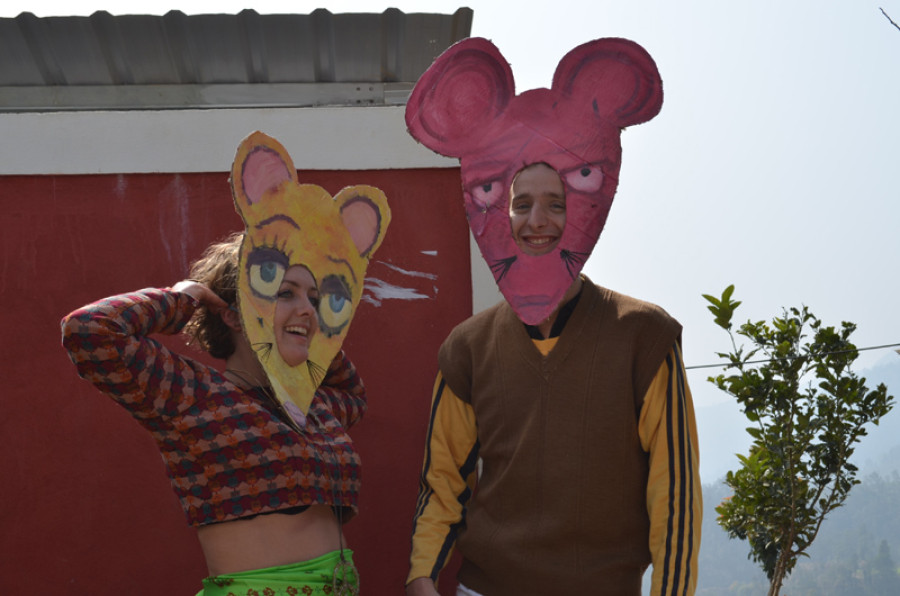Miscellaneous
Trekking theatrics in Sindhupalchok
Our play had no direct message, but tried to promote the simple idea that the art can bring people together, and that anyone has the capacity to be creative
Mark Harris
The local bus rolled into Kiul, Sindhupalchok with a cloud of dust as our eclectic group of artists clambered down the steps with costumes, instruments and backpacks. The first performance was set for the afternoon at a nearby school, and we were already late.
The plan for the weekend was to do a light trek through a couple hills near Melamchi, sharing songs and a short play for the people we met along the way. It was an idea we had been developing for well over a year, as singer David Tashi Lama and I had wandered through the region in the past and had never found a more receptive audience. We had planned to one day bring a travelling band on a village music tour, but the project expanded with the addition of Kathmandu actors Saroj Aryal, and Sujan Shrestha who brought forward the idea of doing theater.
Saroj and Sujan co-wrote the short play in Nepali, with simple lines catered to the non-Nepali speakers who would be performing it. The play, called Musa Ko Basai, or the Migration of Mice, is about a family of mice who are forced to relocate after an earthquake, and cast with members of the Art Haus of Kathmandu. This project was the culmination of a series of weekly meetings held at the Art Haus bringing together artists, musicians and writers to create collaborative projects and to elevate the status of art in Nepal.
The first show was attended by a few hundred students who watched on with curiosity and confusion, as we entered wearing silly costumes and cartoon masks made from cardboard boxes. The band consisting of David Tashi Lama, Max O’Hara, and Henni Saarela opened the program with a rendition of Reshum Fi Riri, that was interrupted midway with frantic drumming and violin to indicate an earth quake. The mice scurried around the makeshift stage until the music came to a close. The foreign actors Enja Saethren, Lee Eames, and this scribe struggled to deliver their basic lines, which added an element of absurdity, and brought out some laughs . At the end of the play David and I sang a handful of Nepali songs that we had been writing together, before continuing up the hill to our next performances.
After the earthquake, there have been a number of arts organisation offering programmes in art therapy , and using theatre to convey social messages. This kind of “development theatre”, typically strives to teach people about sanitation or safe construction in areas with a low level of literacy. While this kind of theatre is a powerful means of communicating messages, making a play fit with an NGO’s outreach strategy doesn’t leave much room for creativity.
Our play in contrast had no direct message, but we tried to promote the simple idea that the art can bring people together, and that anyone has the capacity to be creative. At the end of each program, we encouraged the elders among the audience, to pass on the songs of their parents to the children of today. They in turn responded by gathering for a traditional Tamang Selo, pulling members of our group into the circle and teaching us the steps. It was if to tell us that they knew their songs well.

Still our arrival in the villages was sometimes met with hesitation. With our white faces, broken-Nepali and guitars, some of our hosts initially thought we were Christian missionaries, there to convert the Buddhist village or to one day build a church. But as the evening went on, as we drank and danced with them, singing folk songs and not hymns, it became apparent that we were not there to change anything.
We slept shoulder to shoulder on the mud floors of sheet metal houses. These days, no one builds stones walls higher than a metre. Many of the houses had several sacks of grain, marked with the WFP seal. On a clothes line hung a United Nations branded cap, with its iconic blue colour, likely left behind by an aid worker. Though the shelters were simple, they were wired with electricity, and fitted with proper windows and doors salvaged from ruins. In every village we passed it was evident that people had been working hard to regain a sense of normalcy.
It is obvious that people in these badly-hit regions still need help and that they are victims of a major disaster. Still there is a risk in looking at people as mere helpless victims, and a habit among foreign volunteers to feel like they alone can save them. One aim of this trip was to offer the performers some honest insight into how people are coping and rebuilding. Yes, people are still heavy hearted about their lost loved ones, and there’s a stress about how they might rebuild, but there is a patience and a resilience among them. While the physical structures of their communities may have been totally destroyed, the social bonds between them remain, and have been strengthen through their mutual survival.
Our trek lasted three nights, and held about six performances before everyone returned to Kathmandu, to their jobs and their houses. The experiences of the trek are likely to have a lasting impression, not on the villages who had a brief respite in song and dance, but on those from caught a brief glimpse of the damage and the resilience in rural Sindhupalchok—a place to which many of us have little connection.
Harris is a Kathmandu-based artist and co-founder of the Ekantakuna-based Art Haus




 15.69°C Kathmandu
15.69°C Kathmandu










